

11月8日,2021“今日中国”艺术周开幕。艺术周精心打造了云端展厅,海内外观众可以登录云展厅观展。“希望的田野——中国民生纪实摄影展”“雪域新篇——中国西藏美术摄影展”“天山放歌——中国新疆摄影展”“中日友好自作诗书交流展”4场展览线上展厅陆续在中华数字艺术城推出。
今天,由中国文联、中国外文局主办,中国美术家协会、中国摄影家协会、中国文联网络文艺传播中心承办的“雪域新篇——中国西藏美术摄影展”线上展览正式上线。让我们的目光透过画幅,去领略西藏自然和谐的大美风光、团结奋进的人文风貌和创新发展的时代风尚。快跟随小艺,登录中华数字艺术城一起线上观展吧~
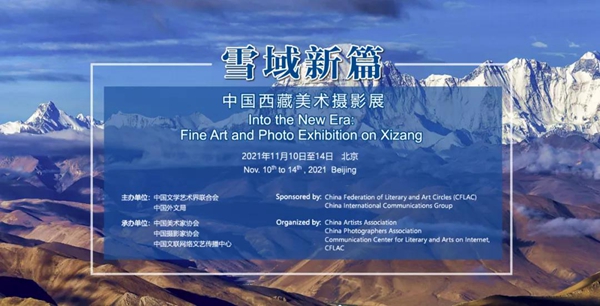
前言
青藏高原,世界屋脊。这里是千山之巅、万水之源,流传着香格里拉的神秘传说。这片雪域胜地,保留着璞玉般的天地灵秀,也涌动着创造美好生活的时代热潮。
2021年是西藏和平解放70周年。当年百万农奴获得自由,掌握了自身命运。经过改革开放,西藏贫穷落后的面貌发生了根本改变。在新世纪里,365万西藏人民实现全面小康,正在翻开建设家园的新篇章。
西藏是文化的沃土。中国的艺术家们在这里有丰富的实践。这里展出近年来西藏主题美术和摄影艺术创作优秀成果共79件。让我们的目光透过画幅,沿着马帮故道和铁轨“天路”,越过连绵的群峰和苍茫的原野,走进西藏古老的寺院、青翠的葡萄园、明媚的山乡和热闹的城市,亲近这里粗犷的汉子、腼腆的少女、矍铄的舞者和欢笑的学生,去领略西藏自然和谐的大美风光、团结奋进的人文风貌和创新发展的时代风尚,去感受雪域高原明锐热烈的视觉印象与旷远淳朴的审美氛围。
让我们祝愿,雪域高原开新篇,西藏明天更美好——扎西得勒!
立体展厅

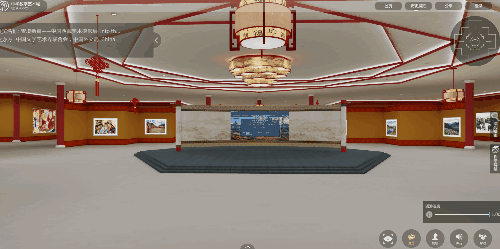
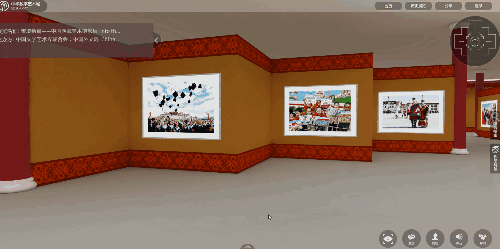
“雪域新篇——中国西藏美术摄影展”线上展厅

观看展览 长按识别图中二维码 进入展厅
走进展厅
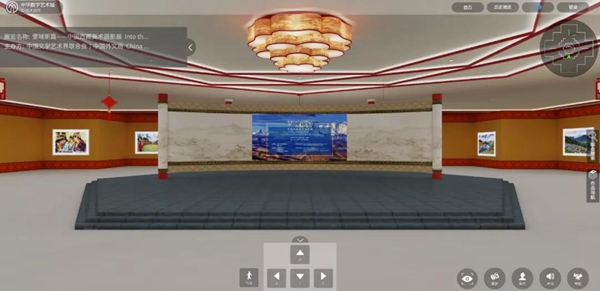
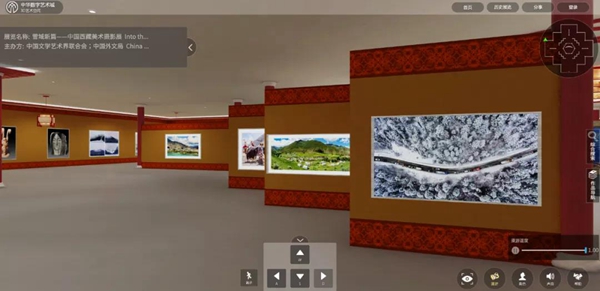
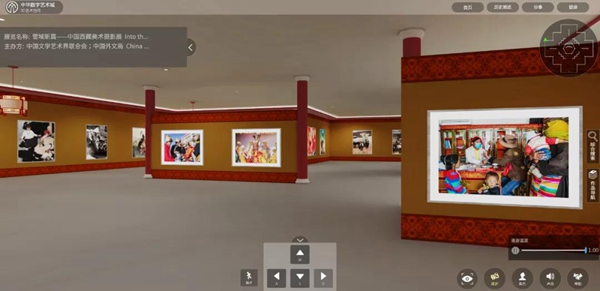
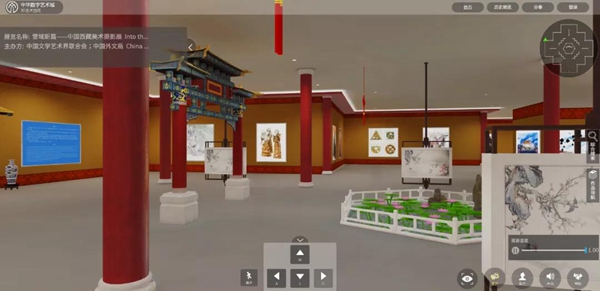
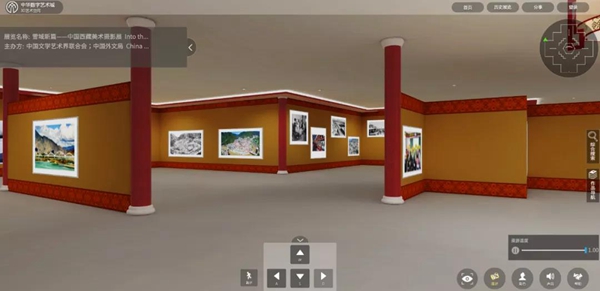
“雪域新篇——中国西藏美术摄影展”线上展厅示意图
作品展示
美术
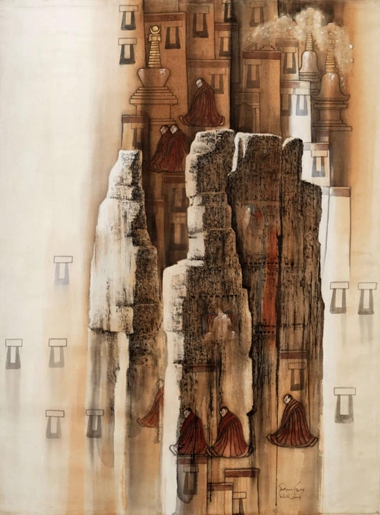
《遥远的风景》 中国画
RemoteLandscape Chinese Painting
边巴 Bian Ba
1973年生于西藏日喀则,藏族。现为西藏自治区美术家协会副主席、秘书长,中国美术家协会理事。
Bian Ba, Tibetan, was born in Shigatse, Xizang in 1973. He is currently the Vice Chairman and Secretary General of Xizang Artists Association, and a director of China Artists Association.
多年前,藏族画家边巴从祖国内地学成归乡。目睹家乡的发展进步,他在倍感欣喜的同时,也敏感地察觉到传统生活方式与现代文明的碰撞,于是从童年记忆汲取灵感,创作了一系列反映这一主题的作品。《遥远的风景》将西藏传统布面重彩画技法与现代艺术形式相融合,在文化内涵和艺术趣味上实现了创新。
Bian Ba, a Tibetan painter, returned to hometown many years ago after his study in inland China. Delighted at the development and progress in his hometown, he was also sensitively aware of the collision between traditional lifestyle and modern civilization. Therefore, he createda series of works with this theme after taking inspiration from childhood memory.Remote Landscape combines the modernart forms with the traditional Tibetan painting techniques of strong colors oncanvas, achieving innovation in cultural connotation and artistic interest.
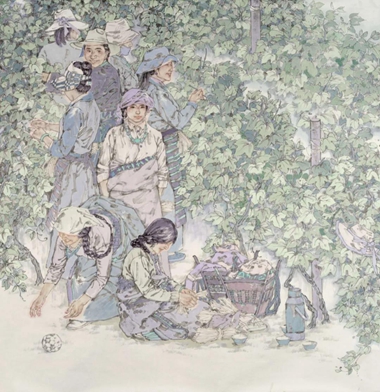
《雅鲁藏布江边的葡萄园》 中国画
Vineyardby the Yarlung Zangbo River Chinese Painting
董从民 刘文涛
Dong Congmin Liu Wentao
董从民,1964年生于内蒙古海拉尔。现为内蒙古艺术学院教授、内蒙古自治区美术家协会主席、中国美术家协会理事。
Born in Hailar, Inner Mongolia in 1964, Dong Congmin is currently a professor at the Inner Mongolia Arts University, Chairman of Inner Mongolia Artists Association, and a director of China Artists Association.
刘文涛,1986年生于内蒙古包头。现为内蒙古师范大学教师。
Born in Baotou, Inner Mongolia in 1986, Liu Wentao is now a teacher at Inner Mongolia Normal University.
西藏有种葡萄、酿红酒的传统。近年来,雅鲁藏布江流域大力发展葡萄种植和红酒酿造,成为群众脱贫增收的“甜蜜”产业。作者途经当地生态移民新村,看到藏族同胞在葡萄园中劳作,被这里浓郁的生活气息和蓬勃的精神风貌深深感染,遂成此作。
There is a tradition of growing grapes andmaking wine in Xizang.The grape planting and wine brewing has been developed vigorously in recentyears in the Yarlung Zangbo River Basin, as a “mellow” industry for local peopleto alleviate poverty and increase income. The painters created this artworkafter deeply appealed by the strong flavor of local life and the vigorous spirit when witnessing Tibetans working in the vineyards in a new localecological immigrant village.
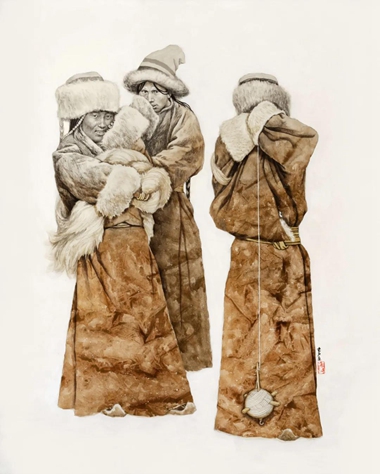
《珞巴人的婚礼》 中国画
Wedding of the Lhoba People Chinese Painting
高毅 黄华三
Gao Yi Huang Huasan
高毅,女,1965年生于北京。现为中国人民大学艺术学院教授、中国女画家协会会员、中国美术家协会会员。
Gao Yi, a female painter, was born in Beijing in 1965. She is currently a professor at the School of Arts, Renmin University of China, a member of China Female Artists Association, and a member of China Artists Association.
黄华三,1966年生于四川成都。现为中国人民大学教授、博士生导师,教育部高等学校美术学类教学指导委员会委员,中国美术家协会理事。
Born in Chengdu, Sichuan in 1966, Huang Huasan is currently a professor and doctoral supervisor at Renmin University of China, a member of the Art Teaching Steering Committee of Higher Education under the Ministry of Education, and a director of China Artists Association
珞巴族世代居住在高山峡谷地带,长期过着与世隔绝的原始部落生活。新中国成立以来,西藏民生条件不断改善,珞巴人也逐渐享受到祥和富足的小康日子。作品描绘了珞巴族喜庆热烈的婚礼场面,展示了珞巴族特有的传统民俗。
The Lhoba people have lived in the mountains and valleys for generations as a primitivetribe in isolation from the rest of the world. However, they have gradually enjoyed a peaceful and prosperous life with the continuous improvement of Tibetan livelihood conditions since the People’s Republic of China was founded. This artwork depicts the festive and bustling wedding scene of the Lhoba people,showing their unique traditional folk customs.
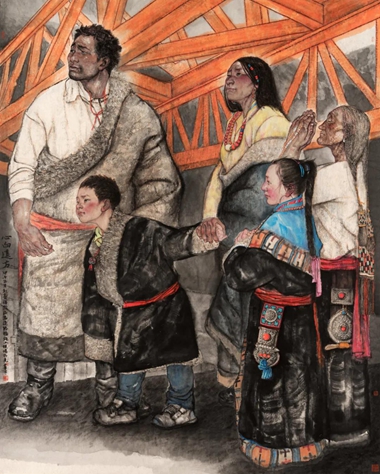
《心向远方》 中国画
Heartto the Distance Chinese Painting
黄华三 Huang Huasan
1966年生于四川成都。现为中国人民大学教授、博士生导师,教育部高等学校美术学类教学指导委员会委员,中国美术家协会理事。
Born in Chengdu, Sichuan in 1966, Huang Huasan is currently a professor and doctoral supervisor of Renmin University ofChina, a member of the Art Teaching Steering Committee of Higher Education under the Ministry of Education, and a director of China Artists Association.
新西藏有新建设。作品选取了藏族牧民一家人的典型形象,将祖孙三代置于路桥施工的背景前。这是一组雕塑式的群像,画中人物都望向远方,表现了对未来美好生活的憧憬与祝祷。
Construction is going on in Xizang. The painter selects a typical family of Tibetan herdsmen, placing three generations against the background of the road and bridge construction sight. It is a set of sculptural group portraits. The characters in the artwork all look into the distance, thus showing their aspiration as well as prayers for an even better life in the future.
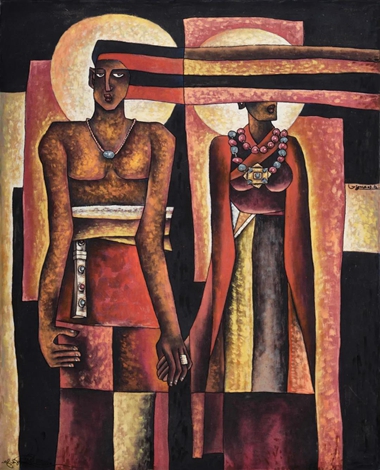
《康巴人》 中国画
The KambaPeople Chinese Painting
计美赤列 Jimei Chilie
1958年生于西藏拉萨,藏族。现为西藏自治区美术家协会副主席、中国美术家协会民族美术艺委会副主任、中国美术家协会会员。
Jimei Chilie, Tibetan, was born in Lhasa, Xizang in 1958. He is currently the Vice Chairman of Xizang Artists Association, the Deputy Director of the Ethnic Art Committee of China Artists Association, and a member of China Artists Association.
康巴地区山清水秀,民风淳朴,家庭和睦。作品用充满装饰感的水墨技法,塑造了一对藏族夫妇手牵手、向前走的场景。那浑厚的造型、粗犷的色调,恰如其分地描绘出了康巴人的神与魂。
The Kamba area is characterized by pictures quescenery, simple folk customs and harmonious families. By means of decorativeink techniques, the painter depicts a Tibetan couple walking forward hand inhand. The strong shape and rough tones appropriately portray the romantic charmand spirit of the Kamba people.
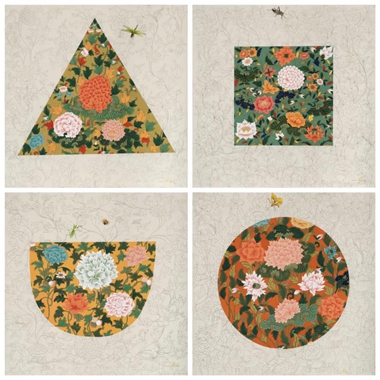
《四季花卉》 中国画
Flowersin Four Seasons Chinese Painting
拉巴次仁 Laba Ciren
1978年生于西藏日喀则,藏族。现为西藏自治区美术家协会副主席,西藏美术院常务副院长、秘书长,中国美术家协会理事。
Laba Ciren, Tibetan, was born in Shigatse, Xizang in 1978. He iscurrently the Vice Chairman of Xizang Artists Association, the Executive Vice President and Secretary-Generalof the XizangAcademy of Fine Arts, and a director of China Artists Association.
唐卡是用彩缎装裱后悬挂供奉的宗教卷轴画,作为西藏的特色绘画形式,传承已逾千年。该作采用唐卡传统的矿物颜料和绘制技法,尝试将传统唐卡艺术与现代装饰题材进行融合创新。画中花卉轮廓借鉴了西藏的五行图案,背景勾线丰富了画面形式,表现了吉祥喜庆的美好寓意,传达出神秘灵动的艺术效果。
Thangka is a religious scroll painting hung and worshiped after mounted with coloredsatin. As a painting form unique to Xizang, it has been passed down for more than a thousand years. Withthe traditional Thangka mineral pigments and painting techniques, the painterattempts to combine traditional Thangka art with modern decorative themes forinnovation. The five-element (metal, wood, water, fire and earth) pattern of Xizang is used forreference to outline the flowers. The delineating modes in the background enrich the picture, expressing good wishes of auspiciousness and celebration,and conveying a mysterious and spiritual artistic effect.
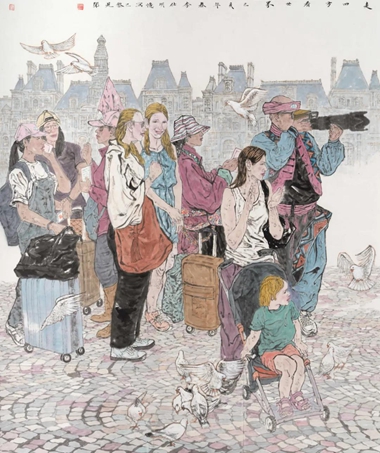
《走四方 看世界》 中国画
GoAbroad, See the World Chinese Painting
李仕明 Li Shiming
1958年生于江西弋阳。现为深圳市龙岗区美协副主席、中国美术家协会会员。
Born in Yiyang, Jiangxi in 1958, Li Shiming is currently the Vice Chairman of Longgang Artists Association, Shenzhen, and amember of China Artists Association.
作品再现了中国游客在巴黎市政厅广场参观游览的场景。人群中,不事声张地站了一位身着民族服装的藏族妇女——今天的西藏群众,同所有的中国人一样,正在以开放的眼光和放松的心情,越来越多地走出国门、拥抱世界。
Thepainter depicts Chinese tourists visiting the Plaza of the Town Hall in Paris,among whom, a Tibetan woman in ethnic costume inconspicuously stands. Just asall Chinese, now Tibetans are going abroad to embrace the world with an openmind and in a relaxed mood.
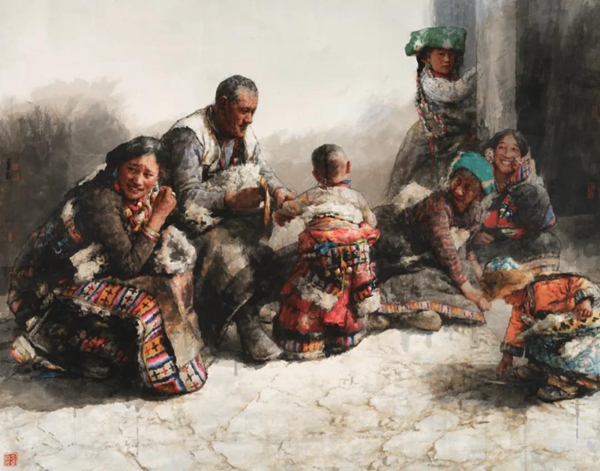
《尘》 中国画
Dust Chinese Painting
南海岩 Nan Haiyan
1962年生于山东平原。现为北京画院专职画家、国家一级美术师、中国美术家协会会员。
Born in Pingyuan County of Shandong in 1962,Nan Haiyan is now a full-time painter of Beijing Fine Art Academy, a nationalfirst-class artist, and a member of China Artists Association.
画家描绘了在西藏写生时邂逅的一个普通藏族家庭——一家老小正在轻松休憩,脸上洋溢着欢喜愉悦。作品标题取自古语“和其光,同其尘”,意为中国传统文化中与世无争的处世之道,在此也表征着藏族同胞淳朴平和的内心世界。作品借鉴西洋画手法,在中国画笔墨的表达方式和表现能力上做出了有益探索。
The painter depicts an ordinary Tibetan family that he met when he was sketching inXizang. All the family members, embalmed in joy, were relaxing in peace. The title of theartwork is derived from an old saying which represents the unworldly lifestyle intraditional Chinese culture as well as the simple and tranquil inner world ofthe Tibetans. The painter has tapped into Western painting techniques and madebeneficial exploration with the rich presentation and expressive ability ofbrushes and ink of traditional Chinese paintings.
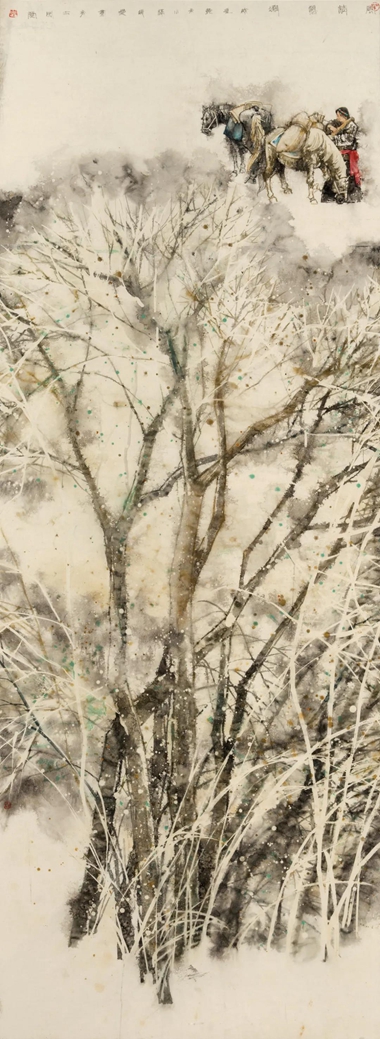
《风清翠凝》 中国画
Cool Breeze and Emerald Green Chinese Painting
钱磊 Qian Lei
1969年生于四川成都。现为成都市美术家协会副主席、四川省美术家协会理事、中国美术家协会会员。
Born in Chengdu, Sichuan in 1969, Qian Lei is currently the Vice Chairman of Chengdu Artists Association, a director of Sichuan Artists Association, and a member of China Artists Association.
初春时节,枝头还挂着料峭的寒霜,春天的脚步已是不可阻挡——藏族姑娘带上行囊,正要走向远方。作品来自画家采风时的真情实感,笔锋灵活精准,墨色疏密变化,用浪漫的手法,勾勒渲染出藏族人民浑厚苍茫的生活环境。
Frost still hangs on the branches, yet the spring is unstoppable. A Tibetan girl is going afar with her luggage. The artwork is derived from the painter’s truefeelings while he was sketching in the fields. The vast but solid backdrop of the Tibetans’ living environment is outlined and rendered with flexible but precise brushstrokes, variable ink colors and romantic techniques.
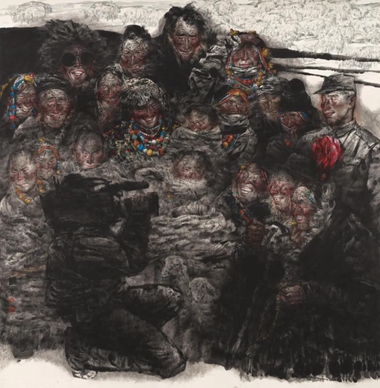
《记录》 中国画
Record Chinese Painting
任惠中 Ren Huizhong
1957年生于山东烟台。现为国防大学军事文化学院教授、中国国家画院研究员、中国美术家协会会员。
Born in Yantai, Shandong in 1957, Ren Huizhong is currently a professor at the Military Culture College of National Defense University, PLA, China, a researcher at China National Academy of Painting, and a member of China Artists Association.
作品表现了藏族青年“一人参军,全家光荣”的感人时刻——一位藏族青年响应国家号召参军,成了家族里的一件大事。出发当天,全家老少纷纷致贺送行。电视台记者也到场采访,记录下了这喜庆的场景。
The artwork shows the touching moment whena Tibetan youth joined the army and brought glory on his whole family. It has become a major event in a Tibetan family for one of its members to join the army inresponse to the call of the country. All the family members shall see him off with congratulations on the day of his departure. In this case, TV reporters also came to make interviews and record this festive scene.
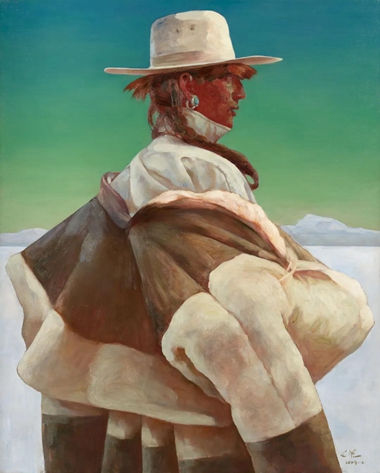
《圣山·高原守护人》 油画
HolyMountain · Guardian of the Plateau Oil Painting
蔡蓉 Cai Rong
蔡蓉,女,1953年生于四川成都。原中国电影艺术研究中心美术编辑、中国美术家协会会员。
Cai Rong, a female painter, was born in Chengdu, Sichuan in 1953. She is the former art editor of China Film Art Research Center, and a member of China Artists Association.
画家曾深入西藏,广泛游历,亲身领略藏族同胞爽朗豁达、乐天知命的人生态度。作品以伫立于阿里高原的藏族汉子为题,表现千百年来他们敬畏上苍、护卫净土的执着坚守。在造型技法上,着力以深沉厚重的肖像感,塑造坚毅阳刚的藏族形象。
Thepainter has traveled extensively in Xizang, and personally felt the Tibetans’ open-minded and optimistic attitude towards life. With a Tibetan man standing on the Ali Plateau as the theme, the artwork shows their persistence in revering the Heaven and defending the Pure Land for thousands of years. The painter strivesto create a resolute and masculine Tibetan image with a dignified sense of portraitin terms of shaping techniques.
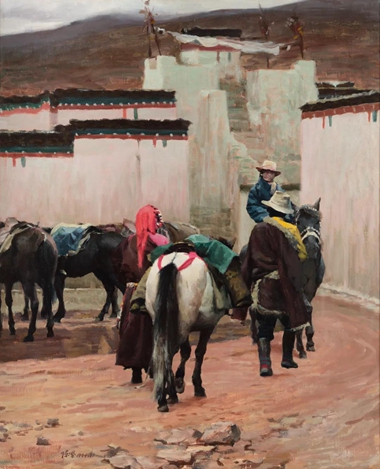
图片《高原之旅》 油画
Journey on the Plateau Oil Painting
陈坚 Chen Jian
1951年生于江苏无锡。原南京军区政治部文艺创作室一级美术师、中国油画学会理事、中国美术家协会会员。
Born in Wuxi, Jiangsu in 1951, Chen Jian is the former first-level artist of the Art Creation Office of the Political Department of the Nanjing Military Region, a director of China Oil Painting Society, and a member of China Artists Association.
高墙壁垒的庄院,迎来了驱策马队的汉子们。高原如海,像这样一站一站的接力,连缀起了历史上的唐蕃古道、茶马古道、南亚廊道。该作采取写实手法,引领观众见证了青藏高原上“南方丝绸之路”厚重的人文历史。
A high-walled Tibetan post house stands toreceive a group of tradesmen driving their packhorses. The plateau, just as thesea, connects the Ancient Chang’an - Tubo (now Xi’an - Lhasa) Road, the Ancient Tea-Horse Road, and the South Asian Corridor in history through the relay fromone post house to another. By virtue of a realistic technique, the artwork guides the viewers to witness the profound cultural history of the “Southern Silk Road” on the Qinghai-Xizang Plateau.
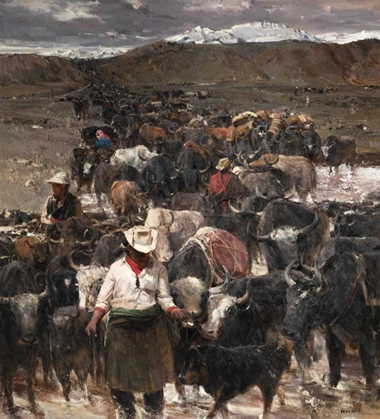
《西藏风情—迁徙》 油画
Charmof Xizang- the Migration Oil Painting
黄胜贤 Huang Shengxian
1974年生于湖南益阳。现为中国艺术研究院中国油画院课题组研究员、中国美术家协会会员。
Born in Yiyang, Hunan in 1974, Huang Shengxian is currently a researcher of Chinese Academy of Oil Painting, Chinese National Academy of Arts, and a member of China Artists Association.
藏族牧民随季节变换转移草场轮牧。迁徙,是他们自古因循的生产生活方式,蕴含着对自然规律的明智遵从。作品运用朴实的素材、宏阔的画面,展现了西藏这一悠远的习俗和独特的风情。
Tibetan herdsmen seasonally change pastures in rotation. Migration, as a production methodand a lifestyle that they have followed since ancient times, is based upon thewisdom of observing the laws of nature. The artwork, with a magnificent configuration of simple materials and elements, shows this long-standing custom and unique lifestyle of the Tibetans.
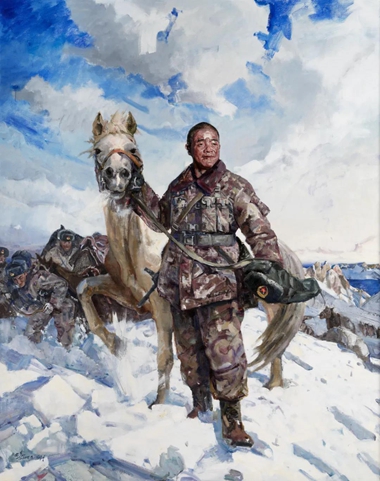
《好男儿》 油画
OurHeroes Oil Painting
罗田喜 Luo Tianxi
1955年生于江西玉山。现为国防大学政治学院教授、中国美术家协会国家重大题材美术创作艺术委员会委员、中国美术家协会会员。
Born in Yushan, Jiangxi in 1955, Luo Tianxiis currently a professor at the Political College of National Defense University, PLA, China, a member of the National Artistic Creation Art Committee of Major Themes, China Artists Association, and a member of China Artists Association.
上世纪50年代,中国人民解放军不畏困苦和牺牲,让西藏迎来了和平解放。70年来,正是这些被称为“铁骨脊梁”的边防官兵,用自己的热血和忠诚,在冰封的高原上筑起了一道牢不可破的钢铁长城。作品笔触坚实、感情饱满,塑造了纪念碑式的中国军人形象。
In the 1950s, undaunted by hardship and sacrifice, the People’s Liberation Army (PLA) facilitated the peaceful liberation of Xizang. Over the past 70 years, it is these frontier soldiers that have built an unbreakable great wall on the frozen plateau with their passion and loyalty. They have earned the acclaim of being the steel backbone of the nation among the fellow countrymen. The artwork here, with solid brushstrokes and rich emotions, creates a monumental image of the Chinese soldiers.
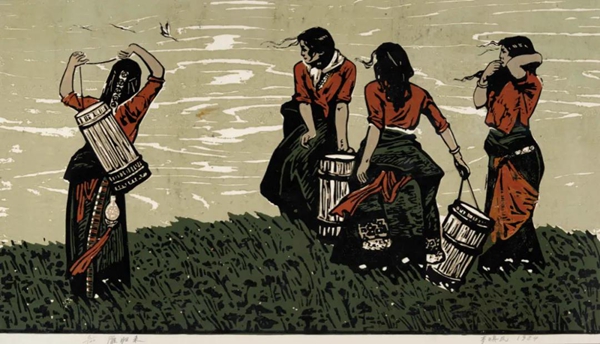
《雁归来》 版画
TheReturn of Wild Geese Print
李焕民 Li Huanmin
1930年生于北京,卒于2016年。曾为中国美术家协会顾问、四川美术家协会名誉主席。
Born in Beijing in 1930 and died in 2016, Li Huanmin was a former consultant of China Artists Association and the Honorary Chairman of Sichuan Artists Association.
李焕民是中国版画艺术史上的一面旗帜,是新中国现实主义思潮中涌现的杰出艺术家。他的艺术生涯与西藏主题密不可分。这幅名作运用质朴的刀味和奔放的套色,着重刻画了藏族牧女集体劳作的场景。这些充满诗意的人物形象,从侧面抒发了西藏民主改革后,藏族人民翻身作主人的喜悦心情,展现出新社会西藏人民舒展昂扬的精神状态。
Li Huanmin is a banner man in the history of Chinese print art and an outstanding artist emerging in the realism trendafter the founding of the People’s Republic of China in 1949. His artistic career is inseparable from the Tibetan theme. This masterpiece, with a simple carving technique and unrestrained color scheme, focuses on a scene of team work by agroup of Tibetan shepherdesses. These poetic figures reflect the joy of Tibetan safter becoming masters of themselves through the democratic reform in Xizang, showing Tibetans’ free spirit and high morale after the liberation.
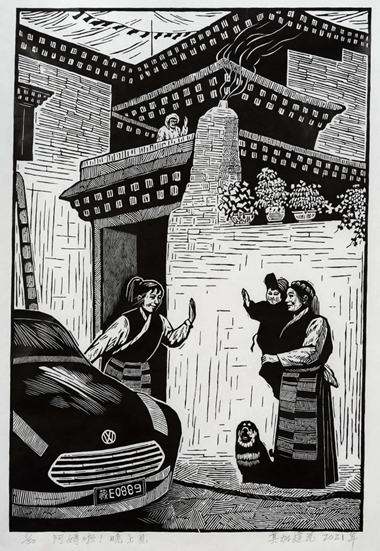
《阿妈啦!晚上见》 版画
SeeYou in the Evening, My Mother! Print
其加达瓦 Qijia Dawa
1946年生于四川甘孜,藏族。现任职于深圳画院,中国美术家协会会员。
Qijia Dawa, Tibetan, was born in the Tibetan Autonomous Prefecture of Garzê, Sichuan in 1946. He is currently working in Shenzhen Fine Art Institute, and a member of China Artists Association.
作品刻画了一个藏族家庭的日常情景——在一处藏族房舍前,女儿准备驾车上班,母亲怀抱外孙出门相送。随着西藏的经济发展和民生进步,藏族同胞们过上了丰衣足食的小康生活,开车出行早已不是什么稀罕事了!
Theartwork depicts the daily scene of a Tibetan family. A young mother is about todrive to work and the grandma holds the grandson to see her off at the frontdoor of their Tibetan house. With the economic development and improvement ofthe people’s livelihood in Xizang,the Tibetans are leading a well-off life with adequate food and clothing. It is no longer a rare sight to see Tibetans driving for a trip.
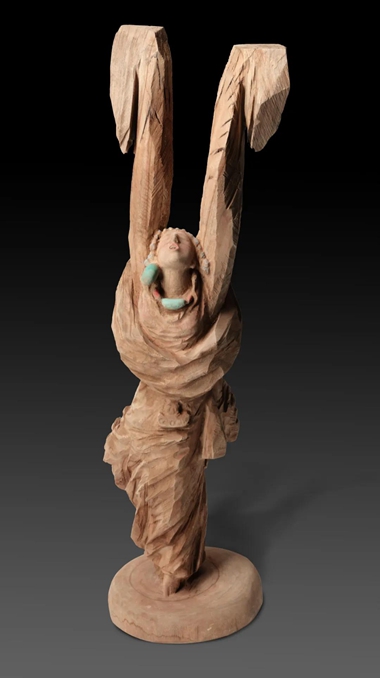
《落雷》 雕塑
Thunder Bolt Sculpture
刘金亭 Liu Jinting
1965年生于辽宁沈阳。现为鲁迅美术学院副教授、中国雕塑家学会会员、陶印艺术馆馆长。
Born in Shenyang, Liaoning in 1965, Liu Jinting is currently an associate professor at Luxun Academy of Fine Arts, a member of China Sculpture Institute, and the Curator of the Ceramic Printing Art Museum.
藏族群众欢庆丰收时,会跳起传统的甩袖舞,表达内心的喜悦和对上苍的感恩。这副木雕作品,抓住藏族女性长袖上甩、望天飞抛的雷霆一瞬,借助简洁硬朗的线条,传递出热烈的动感与充沛的张力。
Tibetans express their delight and gratitude to the Heaven with the traditional long-sleeve dance when celebrating the harvest. This wood carving artwork captures the crucial moment when the Tibetan woman looks at the sky and throws up long sleeves. It conveys a strong sense of movement and an ample tension with the help of simple and tough lines.
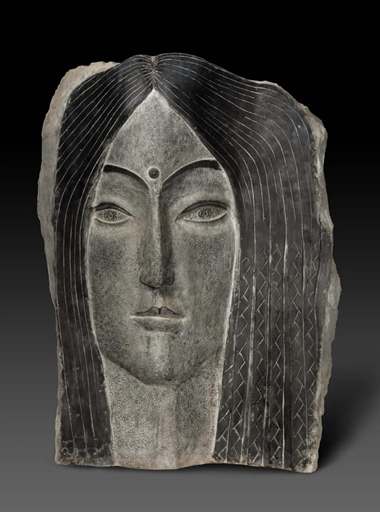
《卓玛》 雕塑
Dolma Sculpture
盛扬 Sheng Yang
1931年生于江苏南京。现为中央美术学院教授、中国美术家协会会员。
Born in Nanjing, Jiangsu in 1931, ShengYang is now a professor at the Central Academy of Fine Arts, and a member of China Artists Association.
“卓玛”是藏族对女子的称呼,意为美丽的女神。作品运用浓郁的装饰风格,刻画了一位藏族少女的形象——发辫精致,神情恬静,富有神韵。这一卓玛的形象,已不再指代具体的某个人,而是力求表现出藏族人民整体的精神气质。
“Dolma” is the Tibetan name for women, meaning a beautiful goddess. The artwork portrays the image of a Tibetan girl in a strong decorative style. She looks tranquiland charming with delicate braids. This image of “Dolma” does not refer to aspecific person, but strives to represent the spiritual temperament of Tibetans as a whole.
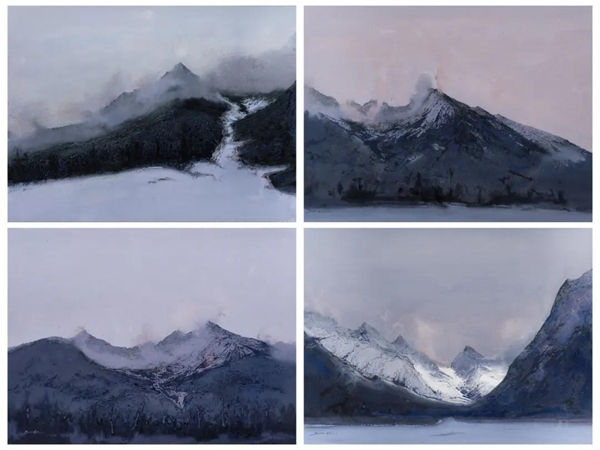
《高原风景》 水彩
Landscapeon the Plateau Watercolor
陆庆龙 Lu Qinglong
1964年生于江苏射阳。现为南京大学艺术学院副院长、教授,江苏省美术家协会副主席、中国美术家协会理事。
Born in Sheyang, Jiangsu in 1964, Lu Qinglong is currently the Deputy Dean and professor of the School of Arts, Nanjing University, the Vice Chairman of Jiangsu Artists Association, and a director of China Artists Association.
珠穆朗玛峰银装高耸,风吹雪洒,宛若女神飘飞的面纱,圣洁而瑰丽。作品撷取西洋画的典雅蕴涵,融合中国水墨的空灵,富有诗意地呈现出恬静空灵的高原美景。
The magnificent holy Mount Qomolangmatowers in the wind and snow. It looks as if a goddess wearing a flying veil.The artwork captures the elegant connotations of Western paintings in combination with the ethereal Chinese ink paintings, poetically presenting the tranquil and transparent beauty of the plateau.
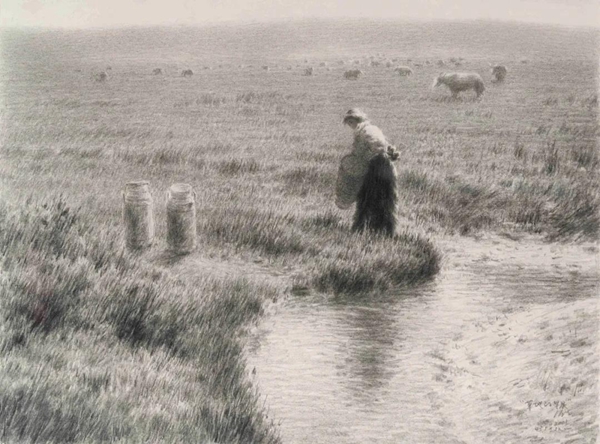
《草地的早晨》 素描
The Morningon the Grassland Sketch
肖涛生 Xiao Taosheng
1946年生于四川成都,卒于2019年。原四川雕塑艺术院副院长、四川美术馆副馆长、中国美术家协会会员。
Born in Chengdu, Sichuan in 1946, and diedin 2019, Xiao Taosheng was the former Deputy Dean of Sichuan Sculpture ArtInstitute, the Deputy Curator of Sichuan Art Museum, and a member of China Artists Association.
这是藏族牧民日常劳作的场景——清晨的光亮清澈透明,广袤的草原上牛群散落,牧民将挤好的牛奶存罐摆放。作品以侧逆光入画,运用挥洒而细腻的笔触,产生了油画般朴实厚重的质感,表达了劳动创造美好生活的深邃喻意。
It is a daily work scene of Tibetan herders. The yak herds are scattered on the vast grassland in the bright and clear morning light, and the herders are milking the yaks for storage in tanks. Drawn in the rembrandt light with casualand delicate brushstrokes, the artwork produces a simple and dense texture likean oil painting, and expresses the profound metaphorical meaning that laborcreates a better life.
摄影

《藏族人家》
1981年,一户藏族人家在收看黑白电视节目。上世纪80年代,电视机在西藏刚刚开始普及,一家人或一村人围在一起看一台电视机是一种新鲜的体验。晚上十点后节目停播,电视机里的结束语成了一家人互道晚安、上床睡觉的信号。
作者:阿多
A Tibetan Family Watching Television
In 1981, a Tibetan family were watching television in black and white. In the 1980s, television was just beginning to become popular in Xizang, and it was a novel experience that a family or a groupof villagers sit together sharing one television. When the show stopped at 10p.m., the goodbye words on the television were also a signal for family members to say good night to each other and go to bed.
By: Aduo
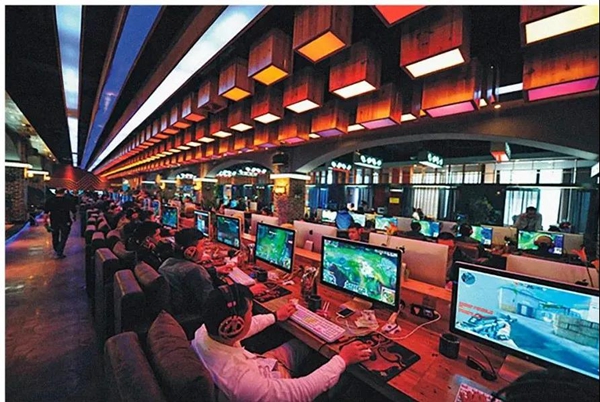
《网络时代》
2015年,西藏已全面迈入信息化时代,正在推进电信网、广播电视网、互联网“三网融合”。人们可以在电视、电脑和手机上随心所欲地点播节目,让个性飞扬,与世界同步。这时候,在互联网营业场所聚会反倒成了年轻人的一种新时尚。
作者:旦增西旦
The Network Age
In 2015, Xizang had already entered the informationage in an all-round way and was making efforts to integrate the telecommunication network, the broadcast network and the Internet. People could request programs of their individual choices on television, computer or mobilephone to keep pace with the world. At that time, it was a new fashion for young people to gather at Internet pubs.
By: Tenzin Xidan
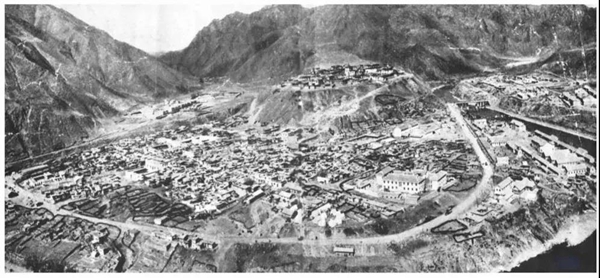
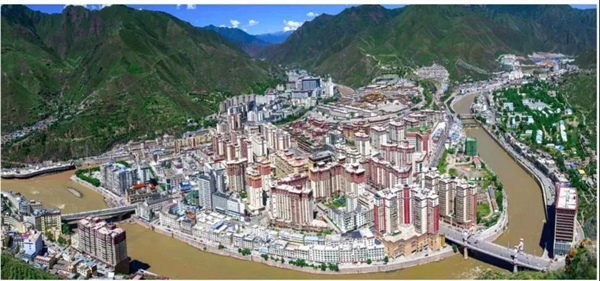
《西藏昌都市鸟瞰(局部)》
昌都是西藏的东大门,是川藏、滇藏公路的必经之地。这座城市坐落在群山怀中,扎曲河和昂曲河在这里相汇为澜沧江——“昌都”在藏语里的意思就是“水汇合处”。在公元7到9世纪的吐蕃时期,这一带是“东女国”的腹地,曾经盛行以女性为中心的社会制度和女性崇拜的独特风俗。
1950年10月,昌都先于拉萨半年得到解放。70年来,昌都地区生产总值和农牧民收入都增长了500多倍。昌都村民阿旺江村说:“作为农奴的后代,我很庆幸自己生在新社会。我们村家家户户都住上了新房,汽车、摩托车、电视机、冰箱、电话、电脑等出行工具和生活电器应有尽有,幸福生活比蜜都还甜。”
上图:1950年摄影。作者:昌都市文联供图
下图:2020年8月摄影。作者:俄波扎西
Bird View of Qamdo City, Xizang(part)
As the eastern gate of Xizang, Qamdo is the place where the Sichuan-Xizang and Yunnan-Xizang railways must pass. Surrounded by mountains, Qamdo means “a meeting place of rivers” in Tibetan language. In fact, the Zachu River and the Angqu River conver gehere into the Lancang River flowing southward. During reign of the Tibetan State from the 7th to 9th centuries AD, here used to be the hinterland of the “Kingdom of Women”, where the female-centered social systemand the unique custom of female worship once prevailed.In October 1950,Qamdo was liberated, half a year earlier than Lhasa. In 70 years, Qamdo’s regional GDP and its per capita income of residents in rural areas have all skyrocketed by over 500 times. Ngawang Jamcan, a local villager said, “As a descendant ofserfs, I’m glad to be born in a new society. Every house hold in our village hasa new house, with cars, motorcycles, TV sets and refrigerators. Mobiles,computers and household appliances can all be found in our village. Now ourlife is sweeter than honey.”
Upperphoto: photographed in 1950, provided by Qamdo Federation ofLiterary and Art Circles
Lowerphoto: photographed in August2020, by Ebo Tashi
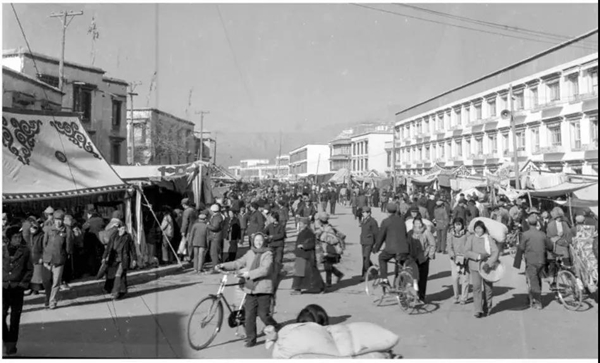
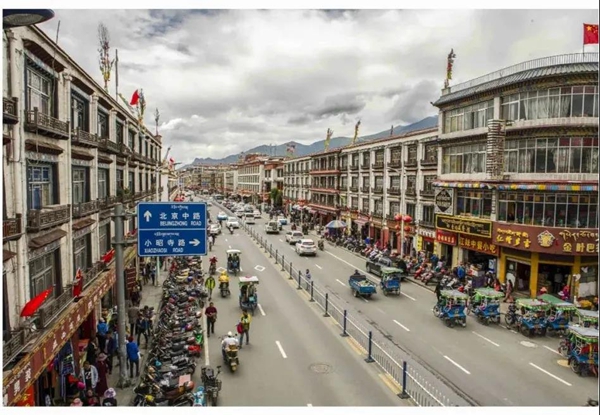
《拉萨市北京中路》
北京路是拉萨市区东西向的中轴干道,因最初由北京援建而得名。它从八廓古城到布达拉宫,横穿过整个市区,串起了万千人家,串起了城市繁华,也串起了历史的印迹与当代的发展。今天的北京路是拉萨最繁华的商业文化街,既弥散着现代城市的时代气息,又流露出古老拉萨的传统韵味。
上图:1984年2月摄影。作者:车刚
下图:2018年6月摄影。作者:南木加
MiddleSection of Beijing Road, Lhasa
Beijing Road in Lhasa is a centralaxis running from east to west, and it got this name for the assistance of Beijing in its original construction. As the busiest city avenue connecting the Barkhor Old Town and the Potala Palace, it not only records the past, but also witnesses the modern development and prosperity of the city, where traditionaland modern elements exist in harmony with each other.
Upper photo: photographed in February 1984, by Che Gang
Lowerphoto: photographed in June 2018,by Namgyal
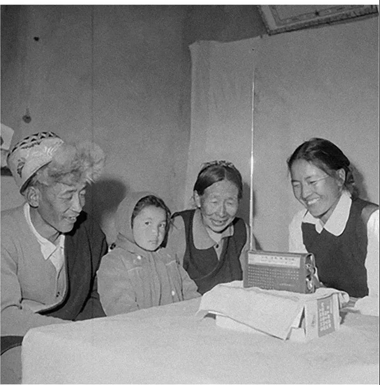
《其乐融融》
1978年,强巴群宗一家在收听广播。1953年10月,西藏第一座广播站——拉萨有线广播站正式播音,后改称西藏人民广播电台,1959年起进行无线广播,每天用藏语和汉语播音8个小时,到1961年10月,无线广播成功覆盖了整个自治区。
作者:尼玛次仁
A Happy Family
In 1978, Champa Chonzom’s family were listening to theradio. In October 1953, Lhasa Cable Broadcasting Station, the first broadcasting station in Xizang,started its official broadcasting. It was later renamed Xizang People’s Broadcasting Station, andits radio programmes were founded in 1959 and were broadcast in Tibetan and Chinese languages for 8 hours every day. By October 1961, radio broadcasting covered the whole autonomous region.
By: Nyima Tsering
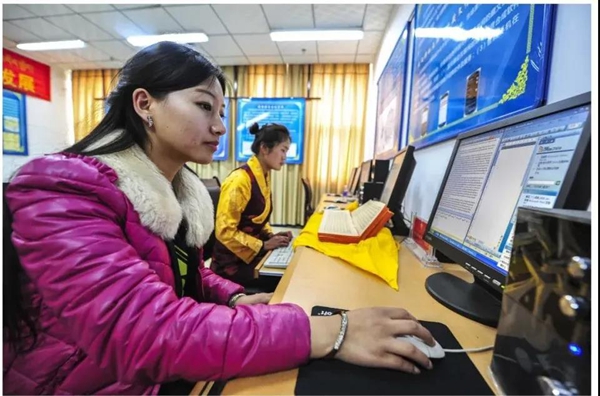
《信息化走进千家万户》
2016年,西藏年轻人在电脑上学习藏文古籍知识。西藏着力打造信息技术与教育教学深度融合的新型学校,努力建设“人人皆学、处处能学、时时可学”的教育信息化体系。到2020年7月,全自治区92%的学校实现了宽带网络接入,957所中小学校有62%配备多媒体终端,一年内将实现全覆盖。自治区每百名学生拥有信息化终端8.22台,在全国处于中等水平。新冠肺炎疫情期间,西藏教育云平台让师生们实现了“停课不停学”。
作者:旦增西旦
Information Age for Everyone
In 2016, young Tibetans were studying ancient Tibetan books on computers. Xizang has increased efforts to build new-typeschools that thoroughly integrate information technology with education and teaching, striving to build an educational informatization system where everyone has access to education anytime and anywhere. By July 2020, 92% schools in the whole autonomous region had broadband network access, 62% amongthe 957 primary and middle schools were equipped with multimedia terminals, and it was estimated that broadband would cover all the schools within one year.The number of information terminals per 100 students in the region was 8.22, a middle level nation wide. Thanks to the Xizang Education Cloud Platform, teaching and learning was not stopped when classes at schools were suspended during the spread of COVID-19 epidemic.
By: Tenzin Xidan
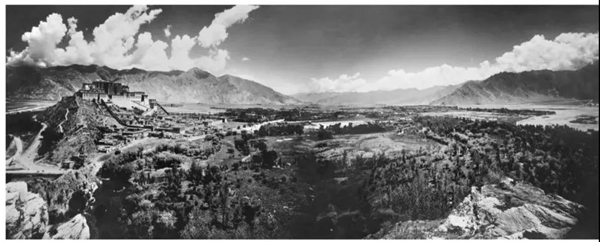
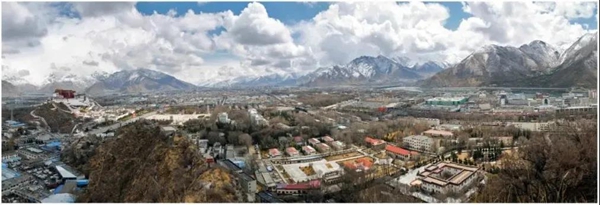
《拉萨鸟瞰(局部)》
1960年1月,拉萨市设立。1965年9月,西藏自治区成立,拉萨市成为首府。改革开放40年,拉萨市区面积从3平方公里扩大到77.9平方公里,增长26倍。2019年,拉萨市户籍人口为55.89万人,比上一年增加了0.45万人。过去十年,拉萨居民收入翻了一番。基本公共教育、社会保险、医疗卫生、社会服务、文化体育等公共服务发展指标达到全国平均水平。
上图:1955年的拉萨。作者:蓝志贵
下图:2020年的拉萨。作者:扎顿
Birdview of Lhasa (part)
Lhasa was designated as a prefecturein January 1960, and was made the administrative capital after the founding ofthe Xizang Autonomous Region in September 1965. Its urban center was expanded from 3 km2 to 77.9 km2 over the 40 years of reform and opening-up, having increasedby 26 times. The permanent population of Lhasa in 2019 was 558,900, increasedby 4,500 compared with that in 2018. The past decade witnessed a doubled income of Lhasa residents. Now, the development indicators of public services likebasic public education, social insurance, medical care, public health and social services, culture and sports facilities have all reached the nationalaverage level.
Upper photo: Lhasa in 1955, by Lan Zhigui
Lower photo: Lhasa in 2020, by Zhadun
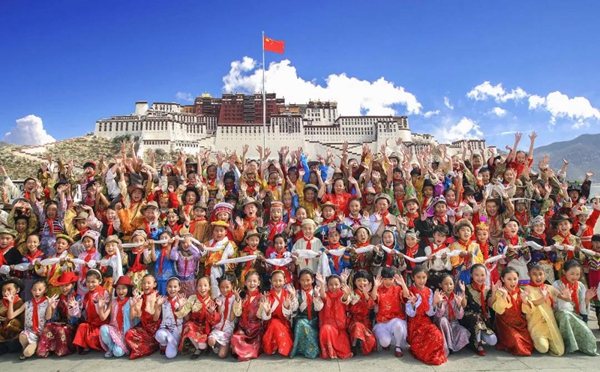
《阳光灿烂》
在旧西藏,占总人口95%的农奴没有受教育的权利,青壮年文盲率超过95%。和平解放后,西藏发展全民普惠的现代教育,已形成覆盖学前教育、基础教育、职业教育、高等教育、继续教育、特殊教育等完整的教育体系。到2020年,全自治区各级各类学校有2995所,其中普通高等学校7所,中等职业学校11所,中学136所,小学821所,特殊学校6所,幼儿园2014所。
照片中这群欢乐的孩子来自拉萨市第一小学。这所拉萨最早的公立小学于1952年建立,距离布达拉宫只有一公里。
作者:索曼尼
In the Bright Sunshine
In old Xizang,serfs, who made up 95% of the population, had no access to education, and there was an illiteracy rate exceeding 95% among young and middle-aged adults. Since the peaceful liberation, Xizang has been making efforts on developing modern education for all. Now it boastsan all-level education system that covers kindergarten, elementary education,vocational education, higher education, adult education and special education.As of 2020, there had been 2,995 schools of all levels, including 7 generalinstitutes for higher education, 11 secondary vocational schools, 136 middles chools, 821 primary schools, 6 special schools and 2,014 kindergartens.
The joyful children in the photo were from Lhasa No.1 Primary School, the earliestpublic primary school in Lhasa built in 1952, which is only 1 km from the Potala Palace.
By: Somaini
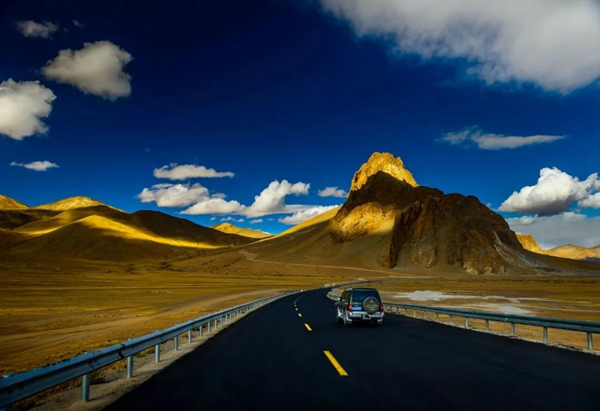
《阿里坦途》
2019年拍摄于西部阿里地区的219国道。
219国道旧时称“新藏线”,总长2140公里。1950年起,总计11万中国军人,付出3000多人牺牲的代价,历时8年建成了这条世界上海拔最高、条件最艰苦的公路。2018年起,新219国道工程启动,向南北延伸,设计总长10065公里,最终将从中国西北端的新疆,贯穿西藏、云南,直到中国西南端的广西,稳居中国里程最长的国道。
作者:黄伦斌
Highwayin Ngari
This photo is the China National Highway 219 (G219) in Ngari Prefecture of Xizang photographed in 2019.
Formerly known as “Xinjiang-XizangHighway”, the traditional G219 ran 2,140 kilometers. Since 1950, atotal of 110,000 Chinese soldiers participated in the construction of this road, and more than 3,000 road builders lost their lives before it was completed 8 years later. It is the highest and probably one of the most challenging motorable roads in the world. In 2018, China decided to extend it with a design length of 10,065 km to connect northwest China’s Xinjiang and southwest China’s Guangxi via Xizang and Yunnan, making it the longest China National Highway once completed.
By: Huang Lunbin
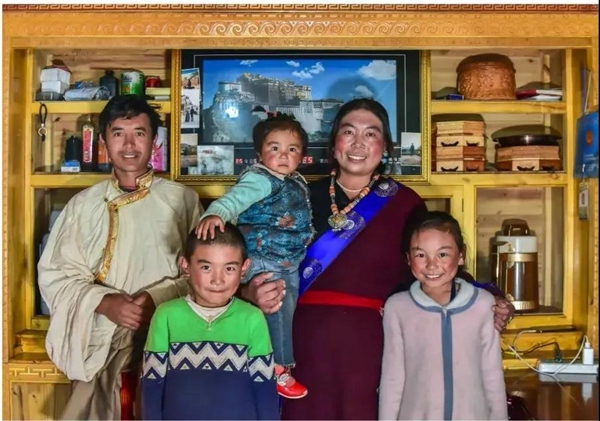
《普巴卓玛一家五口的幸福生活》
2020年拍摄于昌都类乌齐镇。
近年来,昌都共有9.9万名建档立卡的贫困人口告别大山,住进新房,普巴卓玛一家五口便在其中。靠着丈夫江培生格的建筑手艺,夫妻二人同几位邻里一道,承包了周边村民的房屋装饰装修,实现了就近就业,开启了幸福新生活。
作者:卓·丹增曲培
The Happy Life of Phurbu Drolma and Her Family
This photo was photographed in RiwocheTown of Qamdo in 2020.
In recent years, atotal of 99,000 people from registered poor households have moved out of the mountainous areas and into new houses. Phurbu Drolma and her family are also among them. Depending on the crafts in architectural ornament of herhusband Jiangpei Shengge, the couple cooperated with several neighbors and contracted the house decoration of surrounding villagers. Being able to seekemployment locally, they are now living a happy new life.
By: Cho ·Tenzin Choephel
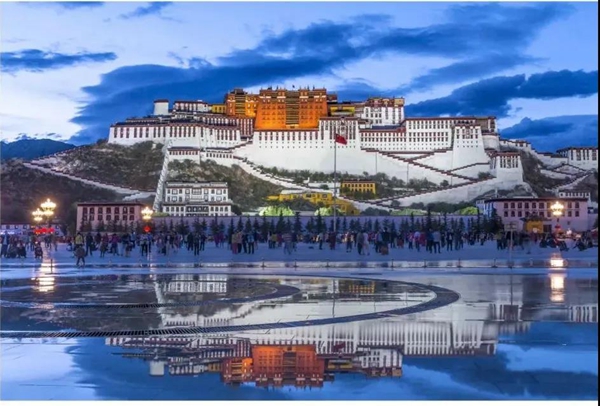
《布宫幻影》
照片拍摄于2018年6月。华灯初上,布达拉宫广场上的音乐喷泉留下薄薄的水迹,映照出布达拉宫的倩影。
布达拉宫是拉萨的标志、西藏的象征。整座宫殿高200多米,雄踞在拉萨西北郊的山岗上,是唐朝时吐蕃的赞普松赞干布为迎娶文成公主而兴建的,已有1390年历史。布达拉宫曾经是西藏政治的中心,现在是收藏丰富的博物馆,也是宗教和艺术的圣地,1994年列为世界文化遗产。
作者:季涛
Reflection of the Potala Palace
This photo was taken in June 2018. With the evening lights lit, the Potala Palace was reflected in the water left by the musical fountain at the Square.
Standing for morethan 200 meters high on a hill at the northwestern outskirts of Lhasa, the Potala Palace is a symbol of Lhasa and Xizang. Songtsan Gambo, ruler of the then TuboKingdom, had the Potala Palace built for Princess Wencheng of the Tang Dynasty, whom he was soon to marry. With a history of 1,390 years, it used to be the political center of Xizang, and now it is a museum of rich collections, as well as aholy land for religion and art. It was inscribed on the World Heritage List in 1994.
By: Ji Tao
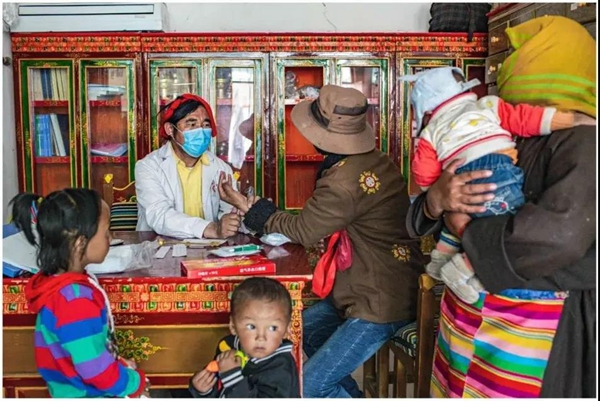
《小镇医生》
2020年8月7日,西藏北部那曲市班戈县的医生为患者把脉。
班戈县是那曲市医疗机构县乡一体化改革试点,目标是实现牧民群众看病“小病不出乡、中病不出县”,在家门口就能享受到优质医疗服务。
作者:刘磊
A Small Town Doctor
On August 7, 2020, a doctor in the Baingoin County of Nagqu innorthern Xizang was feeling the pulse of a patient.
Baingoin is a pilot site of county-townshipintegration reform for medical institutions in Nagqu, with the aim thatherdsmen can enjoy quality medical services locally, where mild and moderate casescan receive medical treatment at township-level and county-level medicalinstitutions respectively.
By: Liu Lei
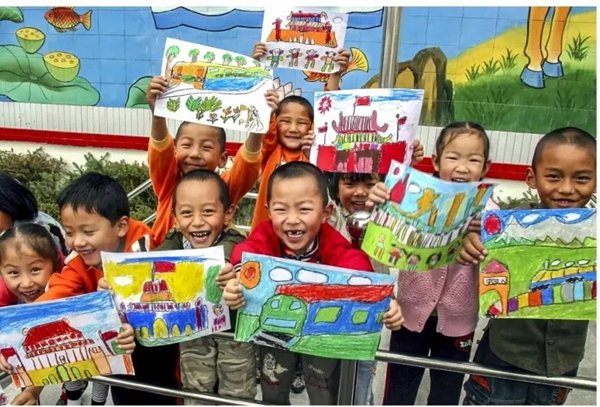
《我心中的天安门和青藏铁路》
在拉萨市实验幼儿园,老师问:“小朋友们最熟悉的画面是什么?咱们把它画出来。”很多孩子不约而同地画出了天安门和青藏铁路。
红、黄、蓝、绿、白……孩子们心中的形象是质朴而生动的,也是有着丰富内涵的。
作者:姚海全
The Tiananmen and the Qinghai-Xizang Railway in My Heart
In Lhasa Experimental Kindergarten, the teacher asked kids, “what’s the most familiar image to you? Let’s paint it.” Many kids painted the Tiananmen and the Qinghai-Xizang Railway.
Red, yellow, blue,green, white… The images in the hearts of the kids are simple, vivid and with rich connotations.
By: Yao Haiquan
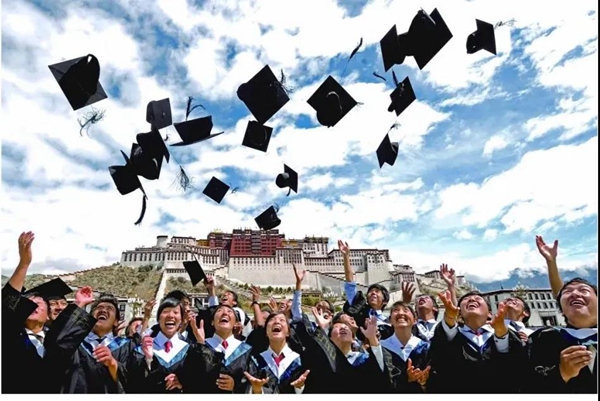
《毕业了!》
2010年6月22日,西藏大学医学院2005级预防医学本科毕业生在布达拉宫广场合影,将学位帽抛向了天空。
该院创建于1972年,累计培养了几千名西藏医疗卫生人才。2020年2月,习近平总书记给该院在首钢医院实习的17名同学回信,鼓励他们毕业后到人民最需要的地方去,以仁心仁术造福人民特别是基层群众。
作者:普布扎西
Graduation!
On June 22, 2010, graduates of Grade 2005 majoring in preventivemedicine in Medical College of Xizang University were taking a group photo at the Polata Palace Square to mark their graduation by throwing the graduation caps into the sky.
Establishedin 1972, the college has altogether cultivated thousands of Tibetan medicaltalents. In February 2020, General Secretary Xi Jinping replied a letter from17 students who were interning at Peking University Shougang Hospital inBeijing, encouraging them to go to places where they were most needed aftergraduation and work for the wellbeing of the people, particularly those oflocal communities.
By: Phurbu Tashi
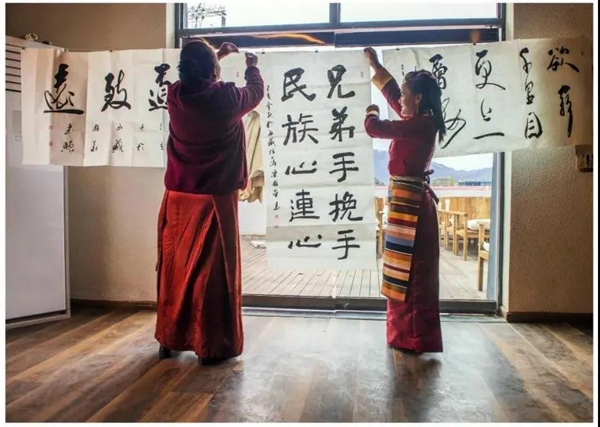
《书法交流》
2019年10月24日,拉萨德吉旅游民宿村里,两位妇女在悬挂书法作品。
“德吉藏家”是在易地扶贫搬迁安置基础上打造的旅游精品民宿村项目,现已成为网红打卡地,让村民们实现了在家门口就业、致富。旅游带动交流,藏族同胞也练起了汉字书法,表达心意,美化生活。
作者:刘英毅
Calligraphy Exchange
On October 24, 2019, two women were hanging calligraphy works in the Diki B&B Resort of Lhasa.
“Dejizangjia Inn”, a Tibetan style hotel, is a specialty tourism and B&B village built on basisof poverty alleviation relocation, and has now become a must-go site famous onthe Internet. In addition to creating local jobs, tourism has also promoted cultural exchange. Many Tibetans are learning Chinese calligraphy to expresstheir feelings and ideas as well as to decorate their houses with artworks.
By: Liu Yingyi
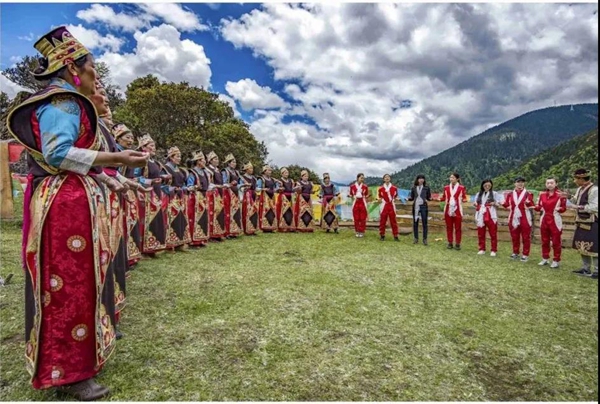
《迎客》
2017年,在“巅峰梦想围棋汽车拉力赛”期间,西藏东部林芝市扎西岗村的妇女们穿上节日盛装,迎接来自远方的女赛车手。
围棋汽车拉力赛是一项助推西藏旅游发展的新兴活动。这一别出心裁的赛事,以西藏高原为主要赛场,很好地将“运筹帷幄”和“决胜千里”结合了起来。
作者:阿旺仁青
Welcoming the Guests
During the “Peak Dream - Auto & Go Chess Rally” in 2017, women in the Zhaxigang Village of Nyingchi in eastern Xizang dressed up to welcome female racing driversfrom afar.
The Auto & Go ChessRally is an event to boost tourism in Xizang. With Tibetan Plateau as the main venue, the eventperfectly combines in-door intelligence competition and out-door auto contest.
By: Ngawang Rinchen
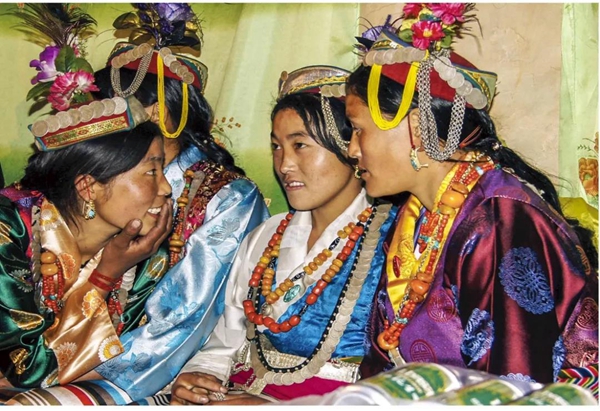
《夏尔巴妇女》
夏尔巴人(藏语意为“来自东方的人”)世代生活在喜马拉雅高山深壑地带,物资进出全靠人扛背驮,妇女也不能幸免。改革开放以来,西藏鼓励开展小额边境贸易。西藏的夏尔巴人背靠祖国、面向南亚,从“喜马拉雅背夫”变成了外贸老板。
作者:西藏摄协供图
Sherpa Women
Sherpas (which means “people from the east” in Tibetan) have lived for generations in the ravines of the Himalayas, where supplies in and outshould all be carried on the back of porters, including women porters.Small-scale frontier trade has been encouraged there since reform and opening-up, turning Tibetan sherpas from “Himalaya porters” into bosses offoreign trade between China and South Asia.
By: provided by Xizang Photographers Association
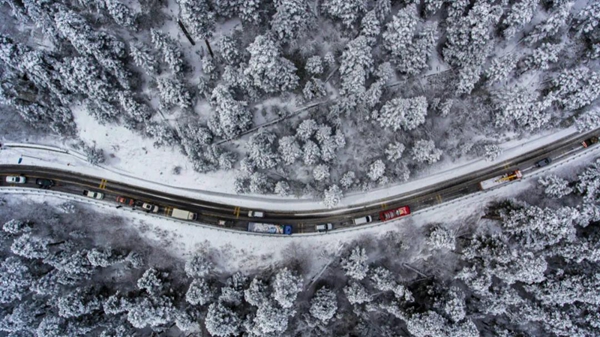
《俯瞰色季拉山路》
2020年,318国道林芝色季拉山下的雪路。
318国道东起上海,西至中尼(泊尔)友谊桥,全长5476公里,目前是中国最长的国道,被誉为“中国人的景观大道”。色季拉山是其中川藏线上的一个著名地标,海拔4728米,在这里转山朝拜的人总是络绎不绝。
作者:南木加
Bird View of the Segrila Mountain Road
This is the snow-covered road at the foot of the Segrila Mountainalong China National Highway 318 (G318).
G318 runsfor 5,476 km from Shanghai to the Sino-Nepal Friendship Bridge. As the longestChina National Highway, it is called the “landscape avenue of the Chinese”.Segrila Mountain is a landmark along the Sichuan- Xizang Highway towering 4,728 m, where pilgrimscan be seen all the time.
By: Namgyal
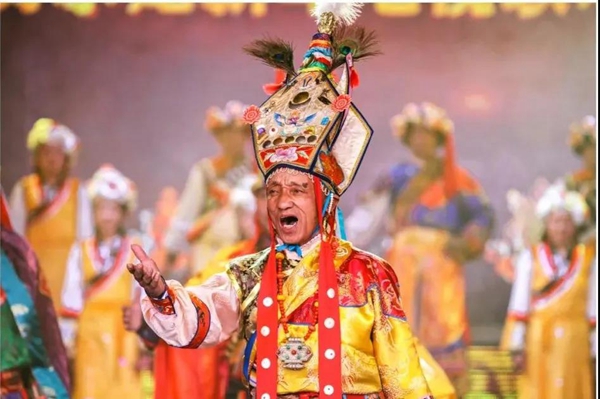
《格萨尔王说唱》
藏族曲艺表演艺术家土登表演《格萨尔王》。
《格萨尔王》是藏民族的代表性史诗,讲述了英雄格萨尔征战四方的故事,口口相传已近千年,凭借其开放式的结构和已有书面记录的40万条诗行,被誉为世界最长史诗和“藏民族的百科全书”。《格萨尔王》说唱作为曲艺品种,主要流传于西藏、青海、四川、甘肃等藏族聚居地区,历经传承创新,生生不息。
作者:日乃
Performance of the Epic of King Gesar
Tibetan famous artist Thubten was performing Epic of King Gesar.
Epic of King Gesaris a thousand-year-old heroic legend created by the Tibetans. With an open structure and 400,000 linesof verse recorded in written, it is considered the longest epic in the worldand an encyclopedic masterpiece that reflects the social and cultural landscapeof ancient Xizang. As a form of folk art blending ballad tellingand singing, it is most popular in Tibetan-inhabited areas such as Qinghai,Sichuan and Gansu. Through in heritance and innovation, its content has been enriched from generation to generation.
By: Rinai
(请横屏欣赏)

《神山的召唤》
这是一组“高原上的高峰”群像,拍摄于2018年6月。在海拔5200米的加乌拉山口观景台,我们从左向右可以依次望见世界第五高峰玛卡鲁峰(Makalu,海拔8463米)、第四高峰洛子峰(Lhotse,海拔8516米)、第一高峰珠穆朗玛峰(Qomolangma/Mount Everest,海拔8844.43米)和第六高峰卓奥友峰(Cho Oyu,海拔8201米)。
作者:季涛
The Call of the Holy Mountains
This is a group portrait of “peaks on the plateau” photographed in June 2018. On the sightseeing platform of Pang-la Pass, we can see Makalu, the 5th highest mountain in the world at 8,463 m, Lhotse, the 4th highest at 8,516 m, Qomolangma/Mount Everest, the highest at 8,844.43 m, and Cho Oyu, the 6th highest at 8,201 m, successively from left to right.
By: Ji Tao
请在WIFI环境下观看
PC机或安卓系统手机运行内存6G以上
